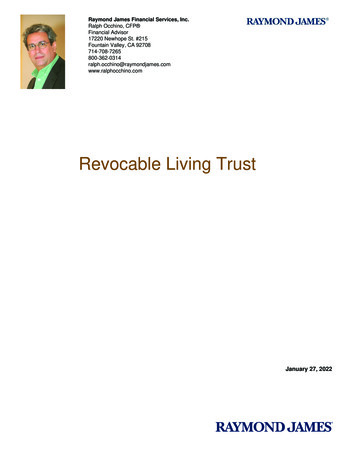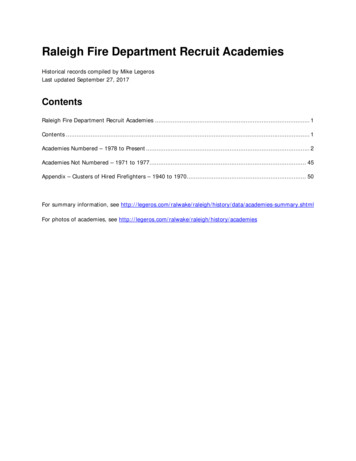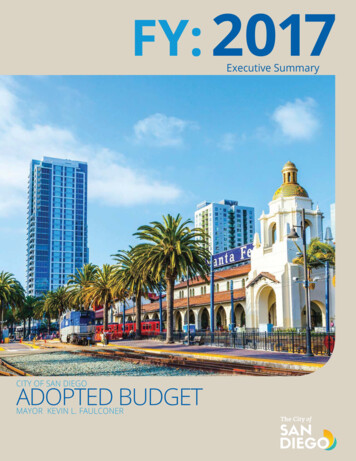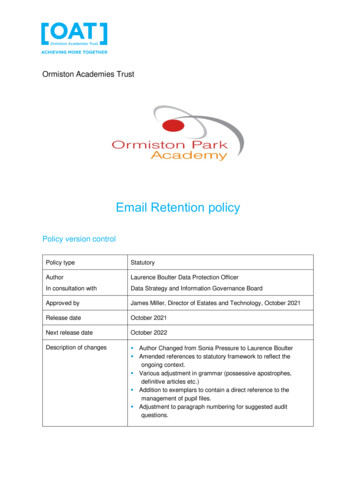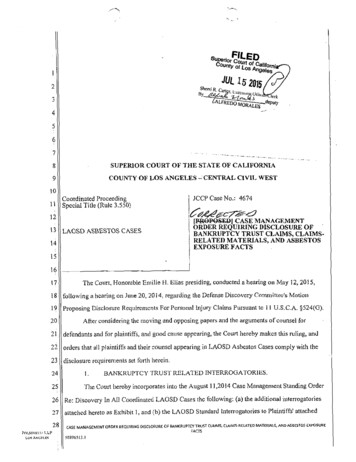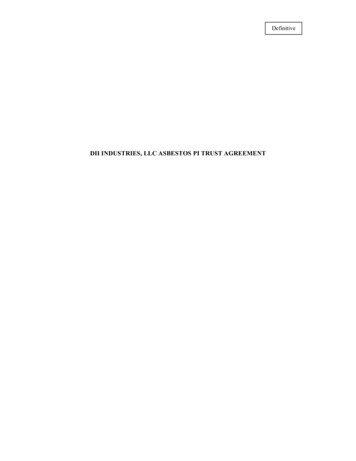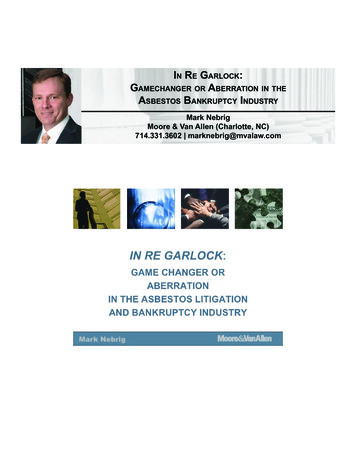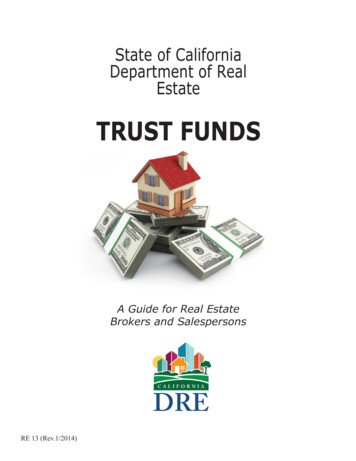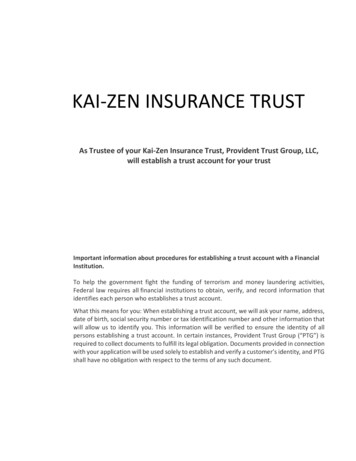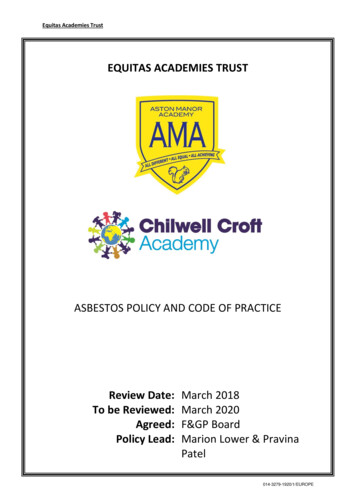
Transcription
Equitas Academies TrustEQUITAS ACADEMIES TRUSTASBESTOS POLICY AND CODE OF PRACTICEReview Date:To be Reviewed:Agreed:Policy Lead:March 2018March 2020F&GP BoardMarion Lower & PravinaPatel1014-3279-1920/1/EUROPE
Equitas Academies Trust1.OVERVIEWThe Health and Safety at Work etc. Act 1974 places overall responsibility for health and safetywith the employer, the Trust, and ultimately the School Management and Governors.The Trust acknowledges its responsibilities to prevent exposure of people to asbestos and thelegislative requirements to manage asbestos. The Trust is committed to providing fullinformation to anyone who may be exposed and affected by asbestos within the school.2POLICY STATEMENTThe Trust is committed to take appropriate precautions to ensure the health andsafety of staff, students and others who may be affected by risks associated withasbestos present in some building structures and equipment.Consequently a system of survey, encapsulation and/or removal has been put in place. Strictsafety protocols have been laid out, which must be adhered to, by those working with or likelyto disturb asbestos products, be they trust, staff or contractors. These systems and safetyprotocols form part of this policy and code of practice thus ensuring that any risk to the healthof employees working directly with or within buildings that contain asbestos building productsor components is reduced to the lowest level reasonably practicable.This policy has been drawn up in accordance with the latest Regulations, Approved Codes ofPractice and Guidance, on asbestos, from Health and Safety Executive and will be reviewedand updated in the light of any future changes to these Regulations, Approved Code of Practiceor Guidance.The Trust will strongly presume the presence of asbestos until proven otherwise.3.OVERVIEW – BACKGROUND INFORMATIONBackground Information‘Asbestos’ is the general term for the fibrous silicates listed in the definition in regulation 2of the Control of Asbestos Regulations 2012 which came into force on 6th April 2012. For anywork covered by these Regulations ‘asbestos’ also includes materials containing any of thesefibrous silicates or mixtures of these fibrous silicates. Three main types of asbestos werecommonly used as follows:(a) Crocidolite (commonly known as blue asbestos);(b) Amosite (commonly known as brown asbestos); and(c) Chrysotile (commonly known as white asbestos).Large amounts of asbestos were used in new and refurbished buildings before 2000. Usagebegan to decline in the 1970s and blue asbestos (crocidolite) had a voluntary ban in 1970. Blueand Brown (amosite) asbestos were banned by law in 1985. Use of white asbestos (chrysotile)were banned in 1999. Everything else and most second hand supply (except for very highperformance materials) was banned by 2000. Therefore, all supply of materials containingasbestos is banned, including making materials available to a third party in any way,whether or not for any payment.2
Equitas Academies TrustAREAS OF ASBESTOSA large number of premises and older plan and equipment still contain some form ofasbestos. Much of the asbestos will be hidden in the fabric of the building so notimmediately obvious – it is also unlikely to be recorded in the building plans. Workersmost likely to come into contact with asbestos-containing products are those in theconstruction, maintenance, refurbishment and related trades. Area where asbestos islikely to be found in schools include: Some ceiling tilesLagging used as thermal insulation on pipes and boilersScience laboratoriesSome textured coatingsSprayed asbestos or asbestos insulating board used for thermal insulation, fireprotection, partitioning and ducts.Asbestos cement roofingTEXTURED DECORATIVE COATINGSTextured decorative coatings which contain asbestos mean thin decorative andtextured finishes such as paints and celling plasters used to produce visual effects.These coatings are designed to be decorative and any thermal or acoustic propertiesare incidental to their purpose. The proportion of asbestos in such coatings is normallybetween 2% and 5% chrysotile.ASBESTOS CEMENTAsbestos Cement is mainly a mixture of chrysotile and cement, which is moulded andcompressed to produce a range of asbestos products such as profiled roofing sheetsand sidings, flat sheet, gutters, drainpipes and flues. Asbestos cement was widely usedon the exterior of buildings and for drainage products and as it is weatherproof andwaterproof will absorb less water. Amosite and/or crocidolite asbestos has also beenused in asbestos cement and may sometimes be present along with the chrysotile butin smaller quantities.ASBESTOS INSULATING BOARDAsbestos Insulating Board (AIB) means any flat sheet, tile or building board consistingof a mixture of asbestos and other materials expect –(a) asbestos cement; or(b) any article of bitumen, plastic, resin or rubber which contains asbestos,and the thermal or acoustic properties of which are incidental to its mainpurpose.AIB is a lightly compressed board made from asbestos fibre and hydrated Portlandcement or calcium silicate with other filler materials. AIB is covered by this definitionwhether or not the board is used for insulation. For instance this definition will stillapply to asbestos insulating board when its main purpose is structure, e.g. as a wallpartition. Asbestos wallboard (a more compressed variety of AIB) will also fall into thiscategory.3
Equitas Academies TrustASBESTOS COATINGAsbestos coating means a surface coating which contains asbestos for fire productionpurposes or as both heat and sound insulation.‘Asbestos coating’ describes the various mixtures containing asbestos, which were widely usedas surface coatings for fire protection purposes or as both heat and sound insulation. Most ofthese coatings were applied by spray but some were applied by hand.4MANAGEMENT OF ABSESTOSTHE TRUST AS THE DUTY HOLDERThe control of Asbestos Regulations 2012 identify in regulation 4 that “the dutyholder” means(a) every person who has, by virtue of a contract or tenancy, an obligation of any extentin relation to the maintenance or repair of non-domestic premises or any means ofaccess or egress to or from those premises: or(b) in relation to any part of non-domestic premises where there is no such contract ortenancy, every person who has, to any extent, control of that part of those nondomestic premises or any means of access or egress to or from those premises.Therefore the duty requires the Trust to: find out if there is any asbestos in the premises, its amount and what condition it is in;make a record of its location and condition;assess the risk from the material and prepare an action plan.alert everyone who needs to know e.g. maintenance workers, about its presence andcondition.If the asbestos is in good condition and is not likely to be damaged, worked on or disturbedthen it does not present a significant risk and it is usually safer to leave it in place and manageit. If the material’s disturbed or becomes damaged then asbestos fibres may be released intothe air and could present a risk to people who breathe them in. Some damaged asbestos canbe made safe by repairing it and either sealing or enclosing it to prevent further damage.Where asbestos cannot be easily repaired and protected it should be removed by someonewho is competent to carry out the task.The most likely way for the asbestos containing materials in schools to be disturbed ordamaged is through maintenance and construction activities, even where the job is small suchas installing telephones, computers or any electrical equipment, shelving and CCTV. Anyone4
Equitas Academies Trustcarrying out such work will need to know that the building contains or may containasbestos, where it is located and its condition.There may well be pressure to remove asbestos unnecessarily, particularly in schools.However, it is important that a proportionate approach is taken to managing the risk fromasbestos in all cases.ASBESTOS MANAGEMENTThe HSG264 Asbestos (the survey guide) has been developed to help people carrying outasbestos surveys and those with specific responsibilities for managing the risks from asbestosin non-domestic premises under regulation 4 of the Control of Asbestos Regulations 2012 (CAR2012). It complements and supports other guidance on managing asbestos.The purpose of the survey is to help manage asbestos in the duty-holder’s premises.The survey has to provide sufficient information for: an asbestos register and plan to beprepared a suitable risk assessment to be carried out and a written plan to manage the risksto be produced.A Management asbestos survey of the Trust has been prepared by Solihull MBC in November2012. Inaccessible areas that were excluded from the survey must be presumed to containasbestos and sampled if work has to be done on them. The survey has been used to compilea register of the Trust’s asbestos containing materials which is held by the Site Manager. A fullcopy of the register is available for inspection.SITE MANAGENETAsbestos containing materials management will be based on a risk assessment. Dependingupon factors such as location, condition, type of material and number of people exposed, oneof the following actions will be taken for all asbestos containing materials within School site:leave, remove, repair or encapsulate. The condition of the asbestos containing materials leftin situ will be inspected and recorded regularly. The frequency of inspection will be based onrisk assessment, identified in the Asbestos Register/Survey.The guidance for this will be sought from the Solihull MBC Property Services Team who willcarry out an annual review of the asbestos within the school.ASBESTOS REGISTERA copy of the Asbestos Register is kept on the Trust and Solihull MBC database as well asphysical copy at the reception. This is accessible to all contractors/staff who may carry outwork on the site. No work is carried out without referral to the register. All Contractors and5
Equitas Academies Trustvisitors who may come into contact with asbestos during their visit are made aware of therelevant dangers.All asbestos containing materials within the Trust have been labelled appropriately and shouldbe left undisturbed.5.PROCEDUREBEFORE COMMENCING WORKBefore any work is carried out on building fabric or fixtures the Asbestos Register mustbe checked for the presence of asbestos containing material. If there is a reason tosuspect that Asbestos exists within the area of work the following must be carried out. Prior to any refurbishment being carried out a refurbishment survey of the area willbe undertaken by a specialist contractor (provided by Solihull MBC) to determine thepresence, or otherwise, of asbestos. The resulting survey will allow for a risk assessment to be produced to identify themethod in dealing with the asbestos if found during the refurbishment survey. Thismay include the safe removal of asbestos prior to the work commencing. If there isany doubt as to the composition of materials uncovered during building works asample will be removed by an approved/competent person and sent to a suitablelaboratory for analysis before work proceeds. This may need the requirement toemploy a competent licensed contractor to remove asbestos material. Advice for thiswill be sought from Solihull MBC Property Services Team.PROCEDURES DURING REFURBISHMENT/REPAIRSContractors/in-house maintenance staff will be fully informed of any known or suspectedasbestos material in the vicinity prior to carrying out any work, which may result indamage/fibre release. They must follow the permit to work system for work areas whereasbestos is or may be present. All contractors involved in any work within school will beexpected to have received Asbestos Awareness training. They will need to prove that this hastaken place.In the event of asbestos (or suspected asbestos) material being discovered unexpectedly orbeing damaged all work must cease and: (a) the area will be sealed off until it has beeninspected by a specialist asbestos contractor or analyst: (b) if the presence of asbestos in a6
Equitas Academies Trustcondition likely to lead to a health risk is confirmed the area will remain sealed and warningnotices will be posted until the asbestos has been removed or sealed.Where asbestos has been positively identified as hazardous and as a result of a riskassessment, sealing or encapsulation is the preferred option this will be carried out byapproved licensed contractors under the guidance of Solihull MBC.Some types of asbestos containing materials may be removed by unlicensed contractors,however this should not be carried out until the material has been identified and removalmethods have been agreed with Solihull MBC property services team.No new asbestos building materials will be used. Asbestos waste, resulting from works carriedout by licensed contractors, will be directly disposed of by the licensed contractor as anintegral part of the contract. Non-compliance with any of the requirements of this Policy willbe deemed a breach of contractor and may be subject to disciplinary procedures.Asbestos plans are located in the Site Managers Office.6.REVIEWThis policy will be reviewed bi-annually by the Premises and Health & Safety committee.Date of next review March 2020I agree to the terms of this code of conduct:PRINT NAME:SIGNATURE:DATE:7
EQUITAS ACADEMIES TRUST ASBESTOS POLICY AND CODE OF PRACTICE Review Date: March 2018 To be Reviewed: March 2020 Agreed: F&GP Board Policy Lead: Marion Lower & Pravina Patel . Equitas Academies Trust 2 1. OVERVIEW The Health and Safety at Work etc. Act 1974 places overall responsibility for health and safety
